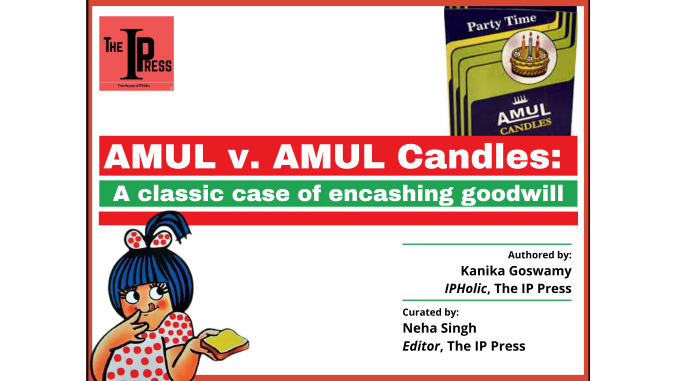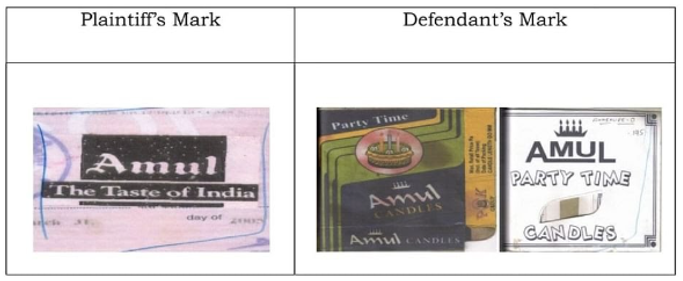
- INTRODUCTION
AMUL has been a part of everyone’s childhood. The delicious treats and wide variety of products that this establishment has to offer have attracted people from every age group. This has allowed them to build a huge empire and branch off into varying fields, from everyday dairy products to manufacturing ice-creams and other sweets.
This has been taken into consideration by the Calcutta High Court while delivering the judgment in the case of Kaira District Cooperative Milk Producers Union Ltd. vs Maa Tara Trading Co.[1] The judgment is yet another beautiful attempt by the Indian Judiciary to elaborate upon the importance of well-known trademarks and the reputation certain brands carry. “AMUL” has been a registered trademark since 1958 and has garnered a reputation for its affordable products that have extended a welcoming hand towards the Indian Rural Community and made such inexpensive goods available to them.
The factual matrix, in this case, was that a local company in West Bengal, Maa Tara Trading Co., started using AMUL’s trademark on the candles that it manufactured and named them “AMUL CANDLES”. The plaintiff came across the advertisements for this brand in February 2020 and filed a suit of injunction for infringement.
This, according to the plaintiff i.e. AMUL, was deceptively similar to their trademark. Further, they contended that the defendant was using the goodwill that they had established in the market after decades of serving the public.
- THE JUDGEMENT
- WHAT IS INFRINGEMENT UNDER THE TRADEMARKS ACT, 1999?
The Calcutta High Court categorically laid down the following arguments while protecting the right of the franchise to avail broad protection even against non-competing goods and services:
- The defendant had used the registered mark of the plaintiff and their actions have led to infringement under Section 29(4)(a), Section 29(4)(b), and Section 29(4)(c) of the Trademarks Act 1999.
- The defendant had misled the public by exploiting the goodwill of the plaintiff.
- The defendant had utilized a well-known mark and designed a mark deceptively similar to the plaintiff’s registered mark.
Before understanding the role that well-known marks play in the market, it is crucial to understand what is infringement. Infringement under The Trademarks Act, 1999 refers to an act of using a registered trademark of a proprietor in such a manner that it is deceptively similar or identical to the original one. The word “deceptively similar” has been defined under Section 2(h) which refers to a mark that bears a resemblance to another mark in such a manner that it can possibly cause confusion in the mind of a consumer.
In the case of Vimal Dairy Limited v. Gujarat Tea Depot Company[2], the court held that the underline intention of a person who suggests adopting either same or deceptively or confusingly similar Trademark is to become unjustly rich by trading upon the goodwill and reputation of the plaintiff.
Further elaborating on the intention, the Delhi High Court held in the case of Delhivery Pvt. Ltd. v. Treasure Vase Ventures Pvt. Ltd[3] that it is settled law that whether two marks are deceptively similar, has to be seen from the perception of an unwary purchaser of ordinary intelligence and flawed recollection. So one can conclude that by deciphering the concept of deceptively similar, the court has to take into consideration the intention followed by the test of the consumer/audience, commonly used in the field of IP.
However, the courts have always allowed the broadening of the horizons in an emerging field like IP. Kirloskar Diesel Recon Pvt. Ltd. v. Kirloskar Propreitary Ltd.[4] is one such example wherein the court emphasized that always interpreting the intention as a fraudulent one is not the right approach. The plaintiffs are not required to prove fraudulent intent or misrepresentation on the part of the defendants if they establish their goodwill.
Infringement in the particular case was prima facie. There is no doubt that a consumer, given the reputation of the plaintiff and the side-by-side representation of the marks, would easily believe that the product belongs to the plaintiff and thus would be more inclined to purchase it.
Since the terminology, “goodwill” is used excessively, defining the same is crucial. Lord Macnaghten[5] defines it as reputation established in the market that attracts the consumers at a large scale.

In the terms of legal parlance, Section 29(4) (a) to (c) lays down definitive methods to make out whether infringement has taken place or not. Clause (a) is essentially elaborating upon the definition of deceptive similarity. Clause (b) and (c) state the alleged infringing mark is utilizing the original mark for products that are not sold by the plaintiff and the infringer is encashing upon the goodwill of the plaintiff, respectively.
Herein, the criteria, as one can observe, is fulfilled. The marks when placed side-by-side look identical. Secondly, the defendant is utilizing it to sell candles whereas the plaintiff is a dairy-based company, and since the plaintiff has recognized all over the country, it can lead to consumers drawing association of the defendant with the plaintiff. Lastly, the defendants have definitely utilized the reputation of the plaintiff to sell their goods.
- WHAT IS PASSING OFF?
The key argument that the court gave is the defendants engaged in the offense of passing off and violated the plaintiff’s registered trademark while also committing the tort of passing off. Passing off is a commonly used terminology and is often confused with infringement in trademarks.
The principle of passing off was laid down in the landmark judgement of Perry v Truefitt[6] as the act of selling someone else’s good as one’s own. The court strictly laid down that nobody has the right to sell somebody else’s goods as their own.
This concept entails three essentials namely:
- Misrepresentation,
- Goodwill,
- Damage.
As laid down under Section 134(1)(c), when the act of passing off is carried out, it is not of importance whether the trademark is registered or unregistered. The elements as defined above have to be established in entirety as held in the case of Britannia Industries Ltd. v. ITC Ltd.[7] If the first element isn’t established, then the court cannot move on to examine other elements.
The fundamentals as enumerated above are quite simple to understand and can be easily interpreted through the factual matrix at hand. The defendant has utilized the trademark of the plaintiff in a manner that leads to misrepresentation in such a manner that the public is led to believe that the defendant is selling the goods or services of the plaintiff.
The goodwill, as abovementioned, has been utilized to sell more goods. The damage so caused, as observed by the court, is to the reputation and revenue of the plaintiff.
- CONCLUSION
The concept of infringement and passing off when applied herein allowed a well-known mark, AMUL, to protect its reputation and curb misrepresentation. AMUL, interestingly, has been granted protection overseas. The Intellectual Property Appellate Board of Canada recognized the reputation and goodwill attached to the tagline of AMUL, The Taste of India. Therefore, any argument from the defendant about not knowing about the reputation of the plaintiff does not stand valid.
REFRENCES
[1] CS/107/2020, judgment dated 01.09.2022
[2] 2021GLH(2)500
[3] CS(COMM) 217/2020
[4] AIR 1996 Bom 149
[5] Inland Revenue v Muller & co’s Margarine Ltd (1901)A.C. 217 at 223-224
[6] (1842).
[7] 2017 (70) PTC 66 (Del)
Kanika Goswamy
Author
Kanika Goswamy, 4th Year BA LLB Specialising in Intellectual Property Rights. My interests lie in sports law and how the multidisciplinary approach that it follows. I further find delight in studying Intellectual Property Rights under the garb of Media and Entertainment Law.
Leave a Reply